Current Property Market Scenario of Australia: An Economic Analysis
VerifiedAdded on 2022/09/17
|12
|3091
|17
Report
AI Summary
This report provides an in-depth analysis of the current Australian property market, examining its structure, competition, and the impact of various economic factors. It explores the market's historical trends, including the rise in property prices and the factors contributing to it, such as government policies, foreign investment, and interest rates. The report investigates the market's oligopolistic structure, identifying key players and the barriers to entry. It further analyzes the current market situation, highlighting the impact of factors like unemployment, wage stagnation, and high household debt on demand and supply dynamics. The report uses graphical illustrations to depict trends in house prices, foreign investment, and the ratio of house prices to income. It also assesses the Reserve Bank of Australia's (RBA) potential monetary policy responses, such as interest rate cuts, and their potential effects on the market. Overall, the report aims to provide a comprehensive understanding of the Australian property market's current state and future outlook.
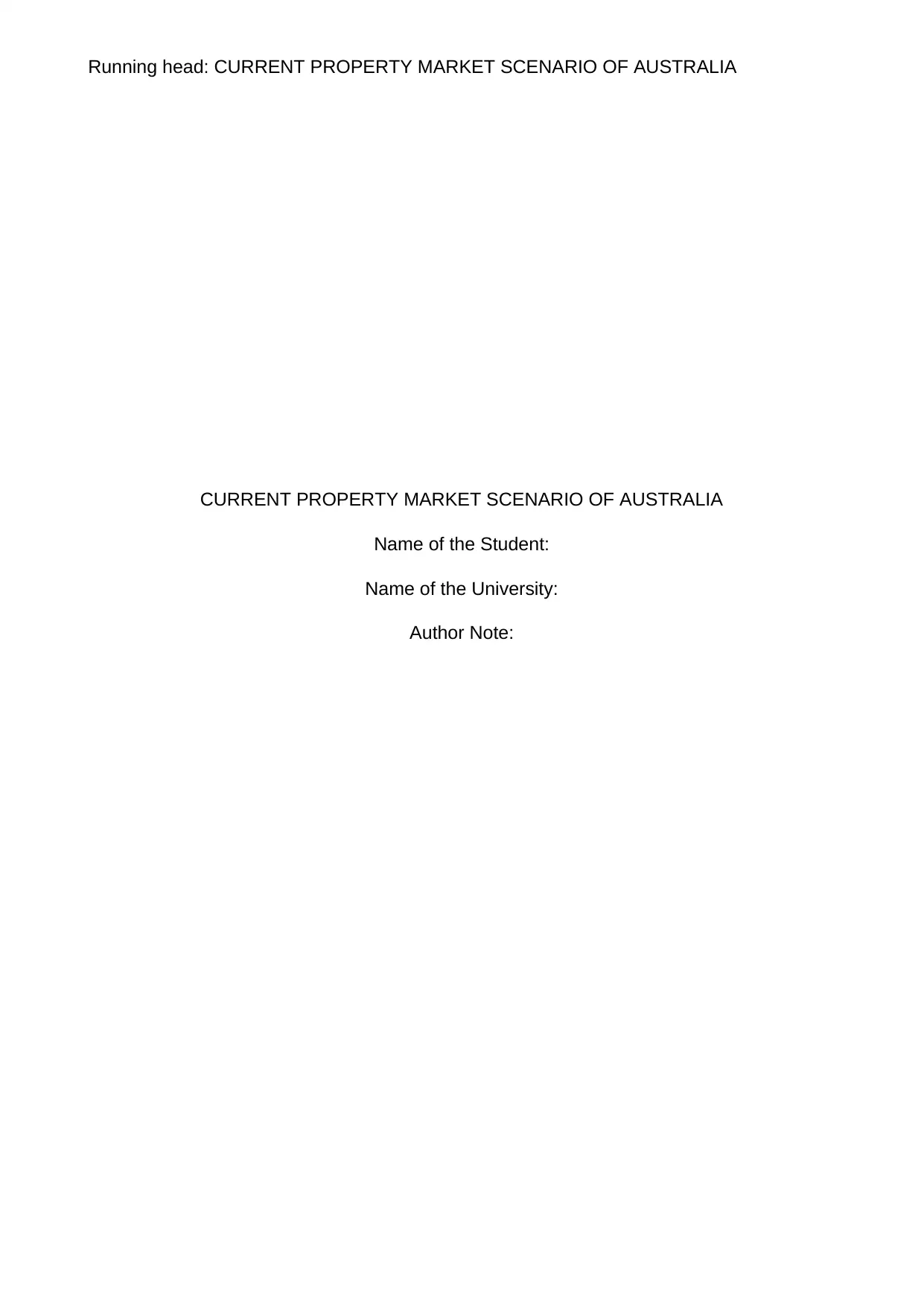
Running head: CURRENT PROPERTY MARKET SCENARIO OF AUSTRALIA
CURRENT PROPERTY MARKET SCENARIO OF AUSTRALIA
Name of the Student:
Name of the University:
Author Note:
CURRENT PROPERTY MARKET SCENARIO OF AUSTRALIA
Name of the Student:
Name of the University:
Author Note:
Paraphrase This Document
Need a fresh take? Get an instant paraphrase of this document with our AI Paraphraser
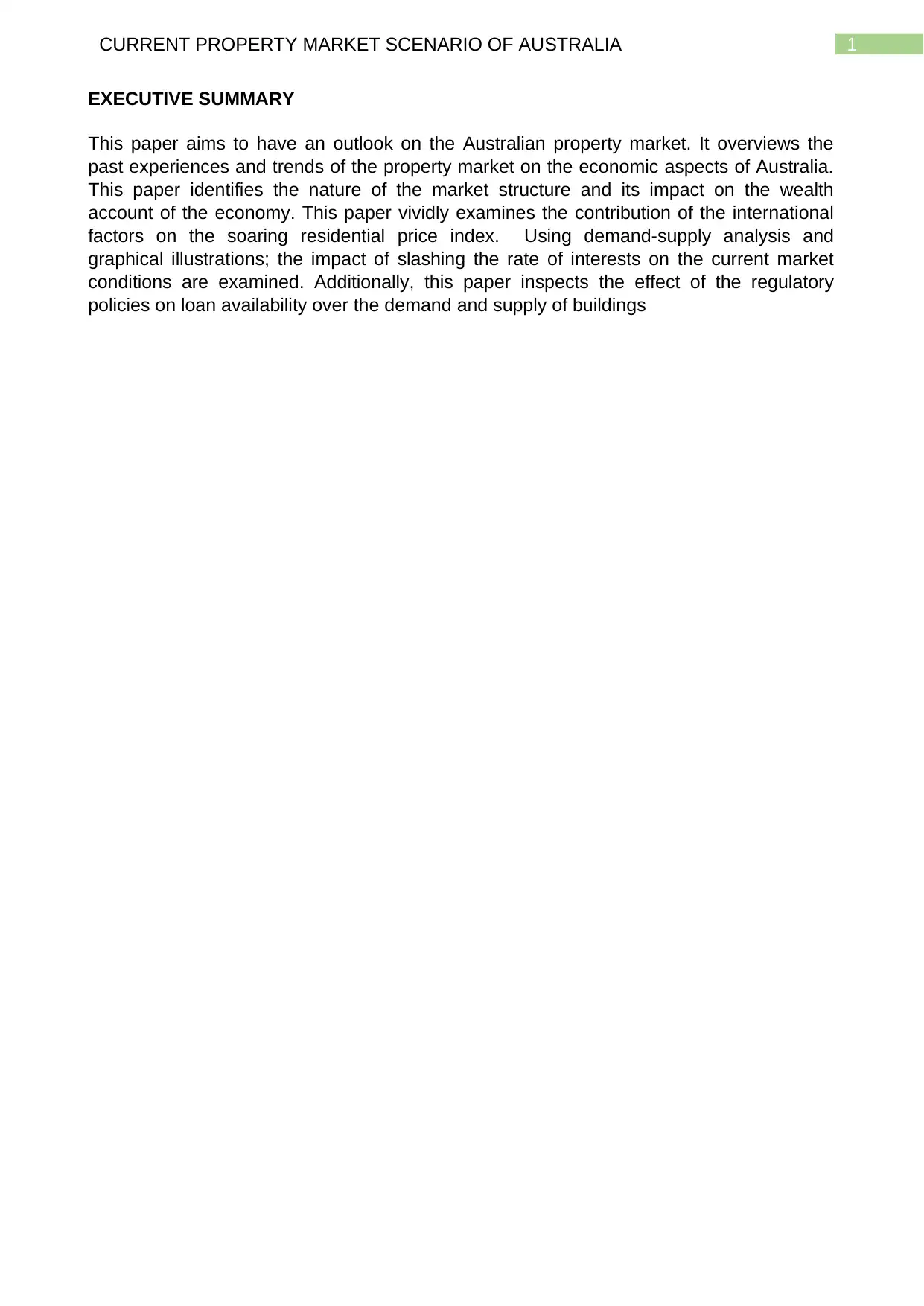
1CURRENT PROPERTY MARKET SCENARIO OF AUSTRALIA
EXECUTIVE SUMMARY
This paper aims to have an outlook on the Australian property market. It overviews the
past experiences and trends of the property market on the economic aspects of Australia.
This paper identifies the nature of the market structure and its impact on the wealth
account of the economy. This paper vividly examines the contribution of the international
factors on the soaring residential price index. Using demand-supply analysis and
graphical illustrations; the impact of slashing the rate of interests on the current market
conditions are examined. Additionally, this paper inspects the effect of the regulatory
policies on loan availability over the demand and supply of buildings
EXECUTIVE SUMMARY
This paper aims to have an outlook on the Australian property market. It overviews the
past experiences and trends of the property market on the economic aspects of Australia.
This paper identifies the nature of the market structure and its impact on the wealth
account of the economy. This paper vividly examines the contribution of the international
factors on the soaring residential price index. Using demand-supply analysis and
graphical illustrations; the impact of slashing the rate of interests on the current market
conditions are examined. Additionally, this paper inspects the effect of the regulatory
policies on loan availability over the demand and supply of buildings
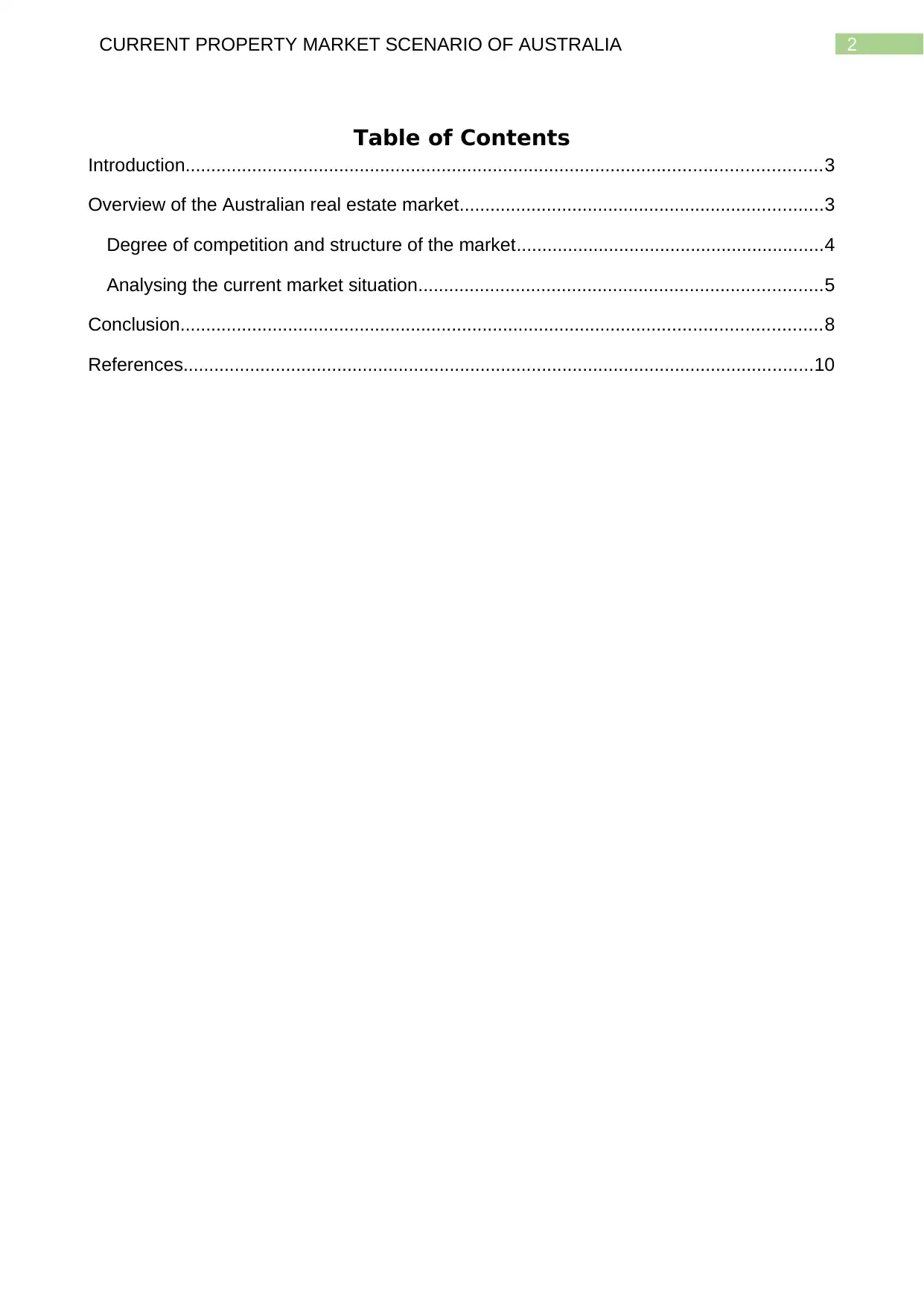
2CURRENT PROPERTY MARKET SCENARIO OF AUSTRALIA
Table of Contents
Introduction............................................................................................................................3
Overview of the Australian real estate market.......................................................................3
Degree of competition and structure of the market............................................................4
Analysing the current market situation...............................................................................5
Conclusion.............................................................................................................................8
References...........................................................................................................................10
Table of Contents
Introduction............................................................................................................................3
Overview of the Australian real estate market.......................................................................3
Degree of competition and structure of the market............................................................4
Analysing the current market situation...............................................................................5
Conclusion.............................................................................................................................8
References...........................................................................................................................10
⊘ This is a preview!⊘
Do you want full access?
Subscribe today to unlock all pages.

Trusted by 1+ million students worldwide
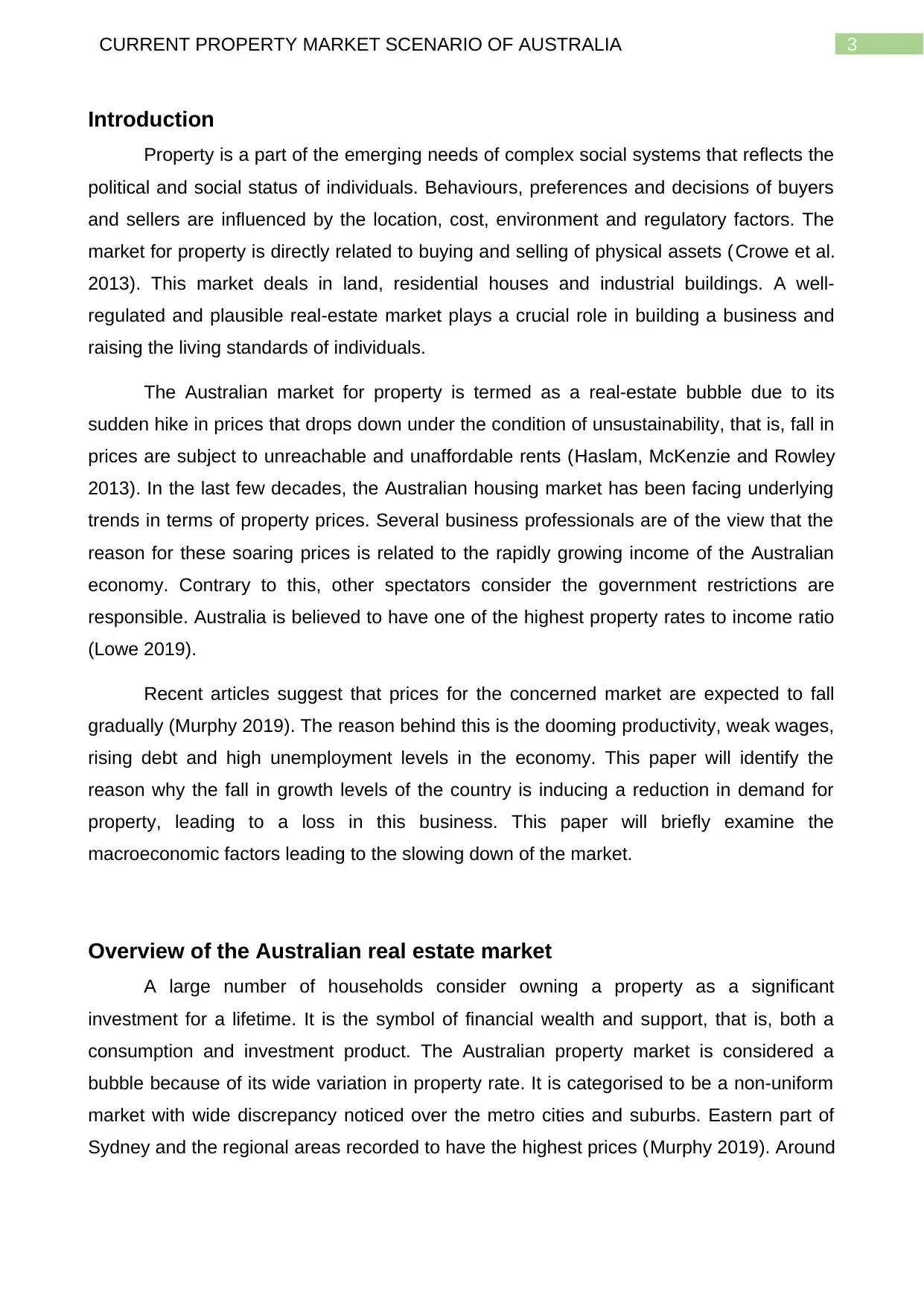
3CURRENT PROPERTY MARKET SCENARIO OF AUSTRALIA
Introduction
Property is a part of the emerging needs of complex social systems that reflects the
political and social status of individuals. Behaviours, preferences and decisions of buyers
and sellers are influenced by the location, cost, environment and regulatory factors. The
market for property is directly related to buying and selling of physical assets (Crowe et al.
2013). This market deals in land, residential houses and industrial buildings. A well-
regulated and plausible real-estate market plays a crucial role in building a business and
raising the living standards of individuals.
The Australian market for property is termed as a real-estate bubble due to its
sudden hike in prices that drops down under the condition of unsustainability, that is, fall in
prices are subject to unreachable and unaffordable rents (Haslam, McKenzie and Rowley
2013). In the last few decades, the Australian housing market has been facing underlying
trends in terms of property prices. Several business professionals are of the view that the
reason for these soaring prices is related to the rapidly growing income of the Australian
economy. Contrary to this, other spectators consider the government restrictions are
responsible. Australia is believed to have one of the highest property rates to income ratio
(Lowe 2019).
Recent articles suggest that prices for the concerned market are expected to fall
gradually (Murphy 2019). The reason behind this is the dooming productivity, weak wages,
rising debt and high unemployment levels in the economy. This paper will identify the
reason why the fall in growth levels of the country is inducing a reduction in demand for
property, leading to a loss in this business. This paper will briefly examine the
macroeconomic factors leading to the slowing down of the market.
Overview of the Australian real estate market
A large number of households consider owning a property as a significant
investment for a lifetime. It is the symbol of financial wealth and support, that is, both a
consumption and investment product. The Australian property market is considered a
bubble because of its wide variation in property rate. It is categorised to be a non-uniform
market with wide discrepancy noticed over the metro cities and suburbs. Eastern part of
Sydney and the regional areas recorded to have the highest prices (Murphy 2019). Around
Introduction
Property is a part of the emerging needs of complex social systems that reflects the
political and social status of individuals. Behaviours, preferences and decisions of buyers
and sellers are influenced by the location, cost, environment and regulatory factors. The
market for property is directly related to buying and selling of physical assets (Crowe et al.
2013). This market deals in land, residential houses and industrial buildings. A well-
regulated and plausible real-estate market plays a crucial role in building a business and
raising the living standards of individuals.
The Australian market for property is termed as a real-estate bubble due to its
sudden hike in prices that drops down under the condition of unsustainability, that is, fall in
prices are subject to unreachable and unaffordable rents (Haslam, McKenzie and Rowley
2013). In the last few decades, the Australian housing market has been facing underlying
trends in terms of property prices. Several business professionals are of the view that the
reason for these soaring prices is related to the rapidly growing income of the Australian
economy. Contrary to this, other spectators consider the government restrictions are
responsible. Australia is believed to have one of the highest property rates to income ratio
(Lowe 2019).
Recent articles suggest that prices for the concerned market are expected to fall
gradually (Murphy 2019). The reason behind this is the dooming productivity, weak wages,
rising debt and high unemployment levels in the economy. This paper will identify the
reason why the fall in growth levels of the country is inducing a reduction in demand for
property, leading to a loss in this business. This paper will briefly examine the
macroeconomic factors leading to the slowing down of the market.
Overview of the Australian real estate market
A large number of households consider owning a property as a significant
investment for a lifetime. It is the symbol of financial wealth and support, that is, both a
consumption and investment product. The Australian property market is considered a
bubble because of its wide variation in property rate. It is categorised to be a non-uniform
market with wide discrepancy noticed over the metro cities and suburbs. Eastern part of
Sydney and the regional areas recorded to have the highest prices (Murphy 2019). Around
Paraphrase This Document
Need a fresh take? Get an instant paraphrase of this document with our AI Paraphraser
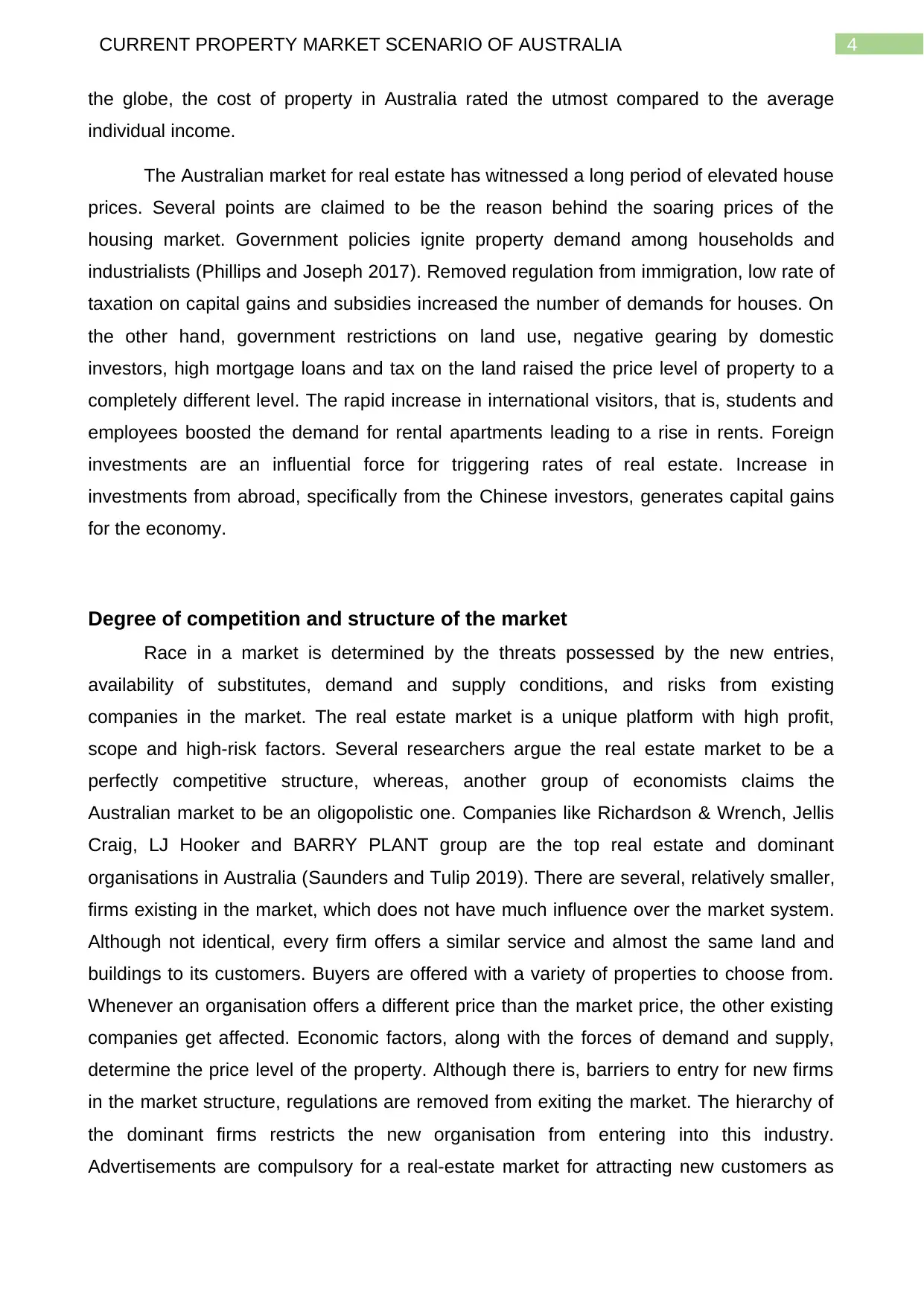
4CURRENT PROPERTY MARKET SCENARIO OF AUSTRALIA
the globe, the cost of property in Australia rated the utmost compared to the average
individual income.
The Australian market for real estate has witnessed a long period of elevated house
prices. Several points are claimed to be the reason behind the soaring prices of the
housing market. Government policies ignite property demand among households and
industrialists (Phillips and Joseph 2017). Removed regulation from immigration, low rate of
taxation on capital gains and subsidies increased the number of demands for houses. On
the other hand, government restrictions on land use, negative gearing by domestic
investors, high mortgage loans and tax on the land raised the price level of property to a
completely different level. The rapid increase in international visitors, that is, students and
employees boosted the demand for rental apartments leading to a rise in rents. Foreign
investments are an influential force for triggering rates of real estate. Increase in
investments from abroad, specifically from the Chinese investors, generates capital gains
for the economy.
Degree of competition and structure of the market
Race in a market is determined by the threats possessed by the new entries,
availability of substitutes, demand and supply conditions, and risks from existing
companies in the market. The real estate market is a unique platform with high profit,
scope and high-risk factors. Several researchers argue the real estate market to be a
perfectly competitive structure, whereas, another group of economists claims the
Australian market to be an oligopolistic one. Companies like Richardson & Wrench, Jellis
Craig, LJ Hooker and BARRY PLANT group are the top real estate and dominant
organisations in Australia (Saunders and Tulip 2019). There are several, relatively smaller,
firms existing in the market, which does not have much influence over the market system.
Although not identical, every firm offers a similar service and almost the same land and
buildings to its customers. Buyers are offered with a variety of properties to choose from.
Whenever an organisation offers a different price than the market price, the other existing
companies get affected. Economic factors, along with the forces of demand and supply,
determine the price level of the property. Although there is, barriers to entry for new firms
in the market structure, regulations are removed from exiting the market. The hierarchy of
the dominant firms restricts the new organisation from entering into this industry.
Advertisements are compulsory for a real-estate market for attracting new customers as
the globe, the cost of property in Australia rated the utmost compared to the average
individual income.
The Australian market for real estate has witnessed a long period of elevated house
prices. Several points are claimed to be the reason behind the soaring prices of the
housing market. Government policies ignite property demand among households and
industrialists (Phillips and Joseph 2017). Removed regulation from immigration, low rate of
taxation on capital gains and subsidies increased the number of demands for houses. On
the other hand, government restrictions on land use, negative gearing by domestic
investors, high mortgage loans and tax on the land raised the price level of property to a
completely different level. The rapid increase in international visitors, that is, students and
employees boosted the demand for rental apartments leading to a rise in rents. Foreign
investments are an influential force for triggering rates of real estate. Increase in
investments from abroad, specifically from the Chinese investors, generates capital gains
for the economy.
Degree of competition and structure of the market
Race in a market is determined by the threats possessed by the new entries,
availability of substitutes, demand and supply conditions, and risks from existing
companies in the market. The real estate market is a unique platform with high profit,
scope and high-risk factors. Several researchers argue the real estate market to be a
perfectly competitive structure, whereas, another group of economists claims the
Australian market to be an oligopolistic one. Companies like Richardson & Wrench, Jellis
Craig, LJ Hooker and BARRY PLANT group are the top real estate and dominant
organisations in Australia (Saunders and Tulip 2019). There are several, relatively smaller,
firms existing in the market, which does not have much influence over the market system.
Although not identical, every firm offers a similar service and almost the same land and
buildings to its customers. Buyers are offered with a variety of properties to choose from.
Whenever an organisation offers a different price than the market price, the other existing
companies get affected. Economic factors, along with the forces of demand and supply,
determine the price level of the property. Although there is, barriers to entry for new firms
in the market structure, regulations are removed from exiting the market. The hierarchy of
the dominant firms restricts the new organisation from entering into this industry.
Advertisements are compulsory for a real-estate market for attracting new customers as
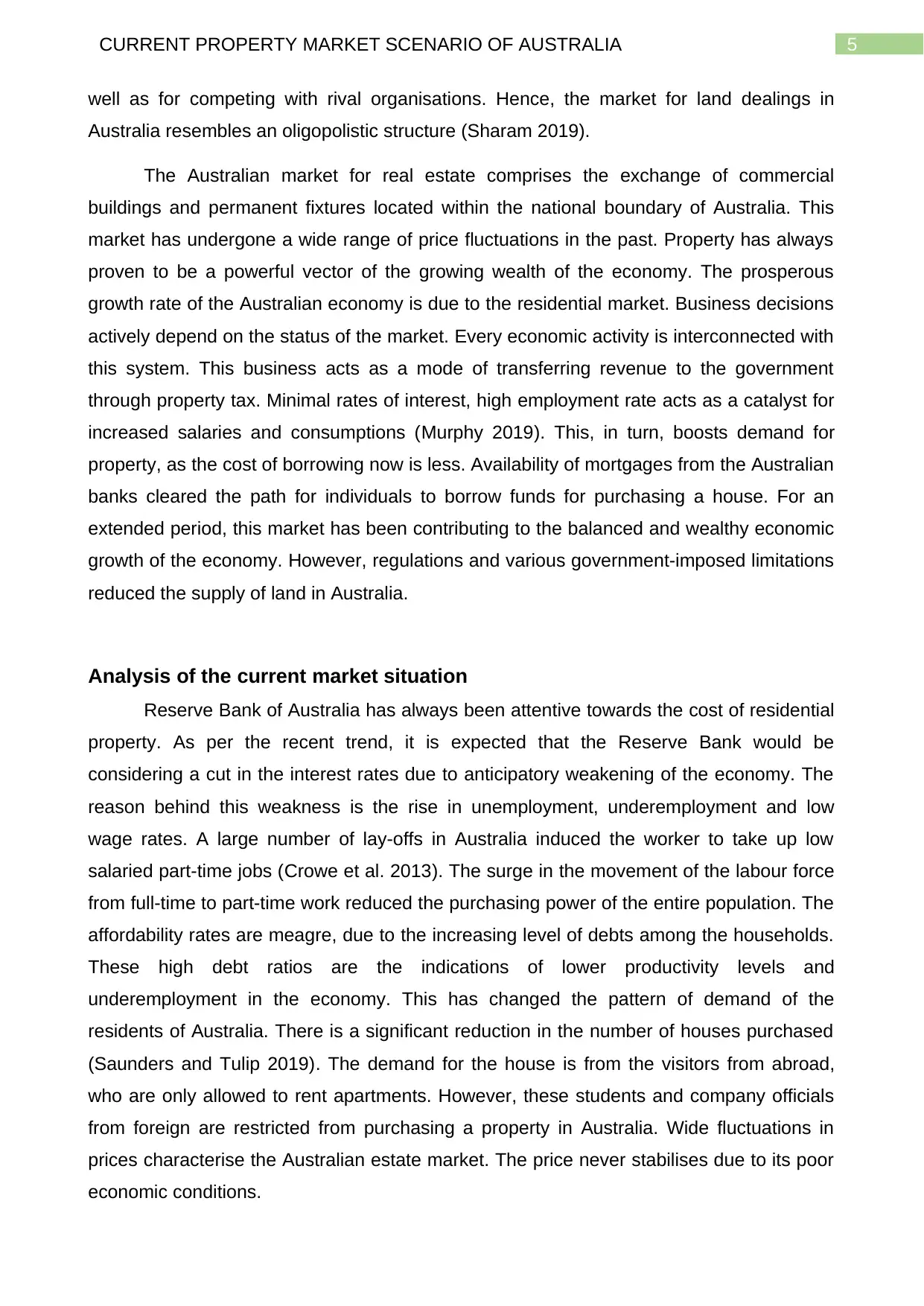
5CURRENT PROPERTY MARKET SCENARIO OF AUSTRALIA
well as for competing with rival organisations. Hence, the market for land dealings in
Australia resembles an oligopolistic structure (Sharam 2019).
The Australian market for real estate comprises the exchange of commercial
buildings and permanent fixtures located within the national boundary of Australia. This
market has undergone a wide range of price fluctuations in the past. Property has always
proven to be a powerful vector of the growing wealth of the economy. The prosperous
growth rate of the Australian economy is due to the residential market. Business decisions
actively depend on the status of the market. Every economic activity is interconnected with
this system. This business acts as a mode of transferring revenue to the government
through property tax. Minimal rates of interest, high employment rate acts as a catalyst for
increased salaries and consumptions (Murphy 2019). This, in turn, boosts demand for
property, as the cost of borrowing now is less. Availability of mortgages from the Australian
banks cleared the path for individuals to borrow funds for purchasing a house. For an
extended period, this market has been contributing to the balanced and wealthy economic
growth of the economy. However, regulations and various government-imposed limitations
reduced the supply of land in Australia.
Analysis of the current market situation
Reserve Bank of Australia has always been attentive towards the cost of residential
property. As per the recent trend, it is expected that the Reserve Bank would be
considering a cut in the interest rates due to anticipatory weakening of the economy. The
reason behind this weakness is the rise in unemployment, underemployment and low
wage rates. A large number of lay-offs in Australia induced the worker to take up low
salaried part-time jobs (Crowe et al. 2013). The surge in the movement of the labour force
from full-time to part-time work reduced the purchasing power of the entire population. The
affordability rates are meagre, due to the increasing level of debts among the households.
These high debt ratios are the indications of lower productivity levels and
underemployment in the economy. This has changed the pattern of demand of the
residents of Australia. There is a significant reduction in the number of houses purchased
(Saunders and Tulip 2019). The demand for the house is from the visitors from abroad,
who are only allowed to rent apartments. However, these students and company officials
from foreign are restricted from purchasing a property in Australia. Wide fluctuations in
prices characterise the Australian estate market. The price never stabilises due to its poor
economic conditions.
well as for competing with rival organisations. Hence, the market for land dealings in
Australia resembles an oligopolistic structure (Sharam 2019).
The Australian market for real estate comprises the exchange of commercial
buildings and permanent fixtures located within the national boundary of Australia. This
market has undergone a wide range of price fluctuations in the past. Property has always
proven to be a powerful vector of the growing wealth of the economy. The prosperous
growth rate of the Australian economy is due to the residential market. Business decisions
actively depend on the status of the market. Every economic activity is interconnected with
this system. This business acts as a mode of transferring revenue to the government
through property tax. Minimal rates of interest, high employment rate acts as a catalyst for
increased salaries and consumptions (Murphy 2019). This, in turn, boosts demand for
property, as the cost of borrowing now is less. Availability of mortgages from the Australian
banks cleared the path for individuals to borrow funds for purchasing a house. For an
extended period, this market has been contributing to the balanced and wealthy economic
growth of the economy. However, regulations and various government-imposed limitations
reduced the supply of land in Australia.
Analysis of the current market situation
Reserve Bank of Australia has always been attentive towards the cost of residential
property. As per the recent trend, it is expected that the Reserve Bank would be
considering a cut in the interest rates due to anticipatory weakening of the economy. The
reason behind this weakness is the rise in unemployment, underemployment and low
wage rates. A large number of lay-offs in Australia induced the worker to take up low
salaried part-time jobs (Crowe et al. 2013). The surge in the movement of the labour force
from full-time to part-time work reduced the purchasing power of the entire population. The
affordability rates are meagre, due to the increasing level of debts among the households.
These high debt ratios are the indications of lower productivity levels and
underemployment in the economy. This has changed the pattern of demand of the
residents of Australia. There is a significant reduction in the number of houses purchased
(Saunders and Tulip 2019). The demand for the house is from the visitors from abroad,
who are only allowed to rent apartments. However, these students and company officials
from foreign are restricted from purchasing a property in Australia. Wide fluctuations in
prices characterise the Australian estate market. The price never stabilises due to its poor
economic conditions.
⊘ This is a preview!⊘
Do you want full access?
Subscribe today to unlock all pages.

Trusted by 1+ million students worldwide
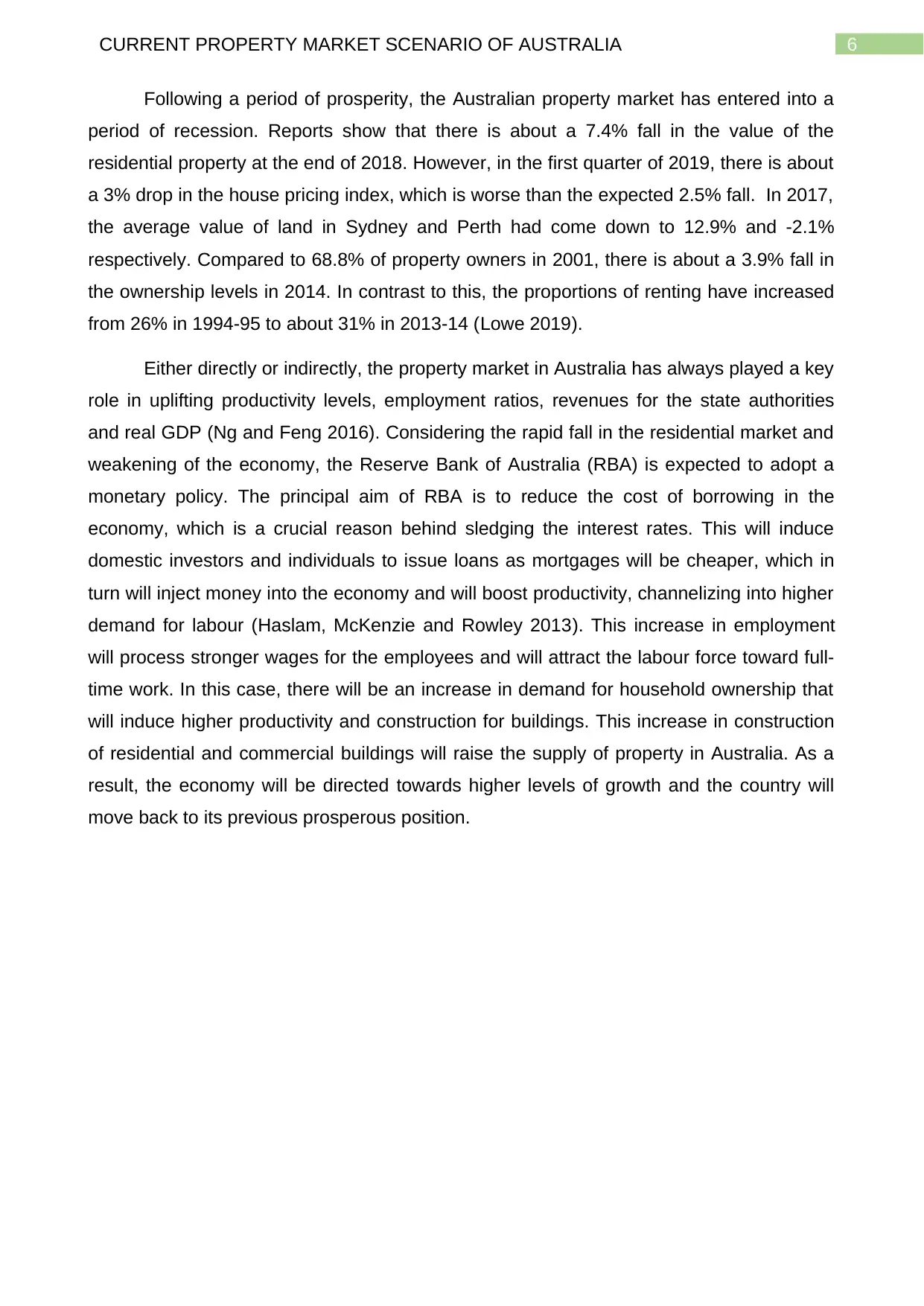
6CURRENT PROPERTY MARKET SCENARIO OF AUSTRALIA
Following a period of prosperity, the Australian property market has entered into a
period of recession. Reports show that there is about a 7.4% fall in the value of the
residential property at the end of 2018. However, in the first quarter of 2019, there is about
a 3% drop in the house pricing index, which is worse than the expected 2.5% fall. In 2017,
the average value of land in Sydney and Perth had come down to 12.9% and -2.1%
respectively. Compared to 68.8% of property owners in 2001, there is about a 3.9% fall in
the ownership levels in 2014. In contrast to this, the proportions of renting have increased
from 26% in 1994-95 to about 31% in 2013-14 (Lowe 2019).
Either directly or indirectly, the property market in Australia has always played a key
role in uplifting productivity levels, employment ratios, revenues for the state authorities
and real GDP (Ng and Feng 2016). Considering the rapid fall in the residential market and
weakening of the economy, the Reserve Bank of Australia (RBA) is expected to adopt a
monetary policy. The principal aim of RBA is to reduce the cost of borrowing in the
economy, which is a crucial reason behind sledging the interest rates. This will induce
domestic investors and individuals to issue loans as mortgages will be cheaper, which in
turn will inject money into the economy and will boost productivity, channelizing into higher
demand for labour (Haslam, McKenzie and Rowley 2013). This increase in employment
will process stronger wages for the employees and will attract the labour force toward full-
time work. In this case, there will be an increase in demand for household ownership that
will induce higher productivity and construction for buildings. This increase in construction
of residential and commercial buildings will raise the supply of property in Australia. As a
result, the economy will be directed towards higher levels of growth and the country will
move back to its previous prosperous position.
Following a period of prosperity, the Australian property market has entered into a
period of recession. Reports show that there is about a 7.4% fall in the value of the
residential property at the end of 2018. However, in the first quarter of 2019, there is about
a 3% drop in the house pricing index, which is worse than the expected 2.5% fall. In 2017,
the average value of land in Sydney and Perth had come down to 12.9% and -2.1%
respectively. Compared to 68.8% of property owners in 2001, there is about a 3.9% fall in
the ownership levels in 2014. In contrast to this, the proportions of renting have increased
from 26% in 1994-95 to about 31% in 2013-14 (Lowe 2019).
Either directly or indirectly, the property market in Australia has always played a key
role in uplifting productivity levels, employment ratios, revenues for the state authorities
and real GDP (Ng and Feng 2016). Considering the rapid fall in the residential market and
weakening of the economy, the Reserve Bank of Australia (RBA) is expected to adopt a
monetary policy. The principal aim of RBA is to reduce the cost of borrowing in the
economy, which is a crucial reason behind sledging the interest rates. This will induce
domestic investors and individuals to issue loans as mortgages will be cheaper, which in
turn will inject money into the economy and will boost productivity, channelizing into higher
demand for labour (Haslam, McKenzie and Rowley 2013). This increase in employment
will process stronger wages for the employees and will attract the labour force toward full-
time work. In this case, there will be an increase in demand for household ownership that
will induce higher productivity and construction for buildings. This increase in construction
of residential and commercial buildings will raise the supply of property in Australia. As a
result, the economy will be directed towards higher levels of growth and the country will
move back to its previous prosperous position.
Paraphrase This Document
Need a fresh take? Get an instant paraphrase of this document with our AI Paraphraser
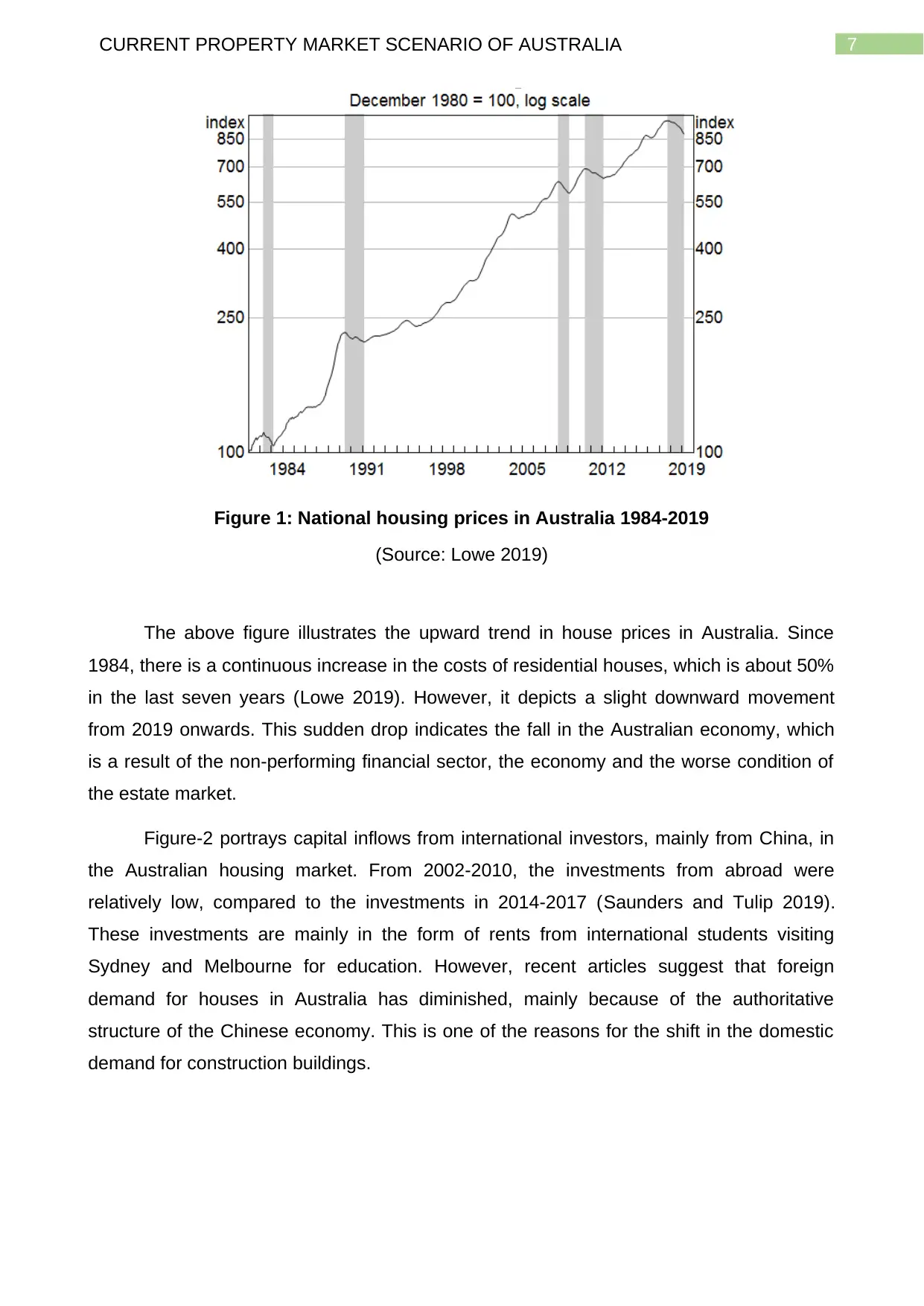
7CURRENT PROPERTY MARKET SCENARIO OF AUSTRALIA
Figure 1: National housing prices in Australia 1984-2019
(Source: Lowe 2019)
The above figure illustrates the upward trend in house prices in Australia. Since
1984, there is a continuous increase in the costs of residential houses, which is about 50%
in the last seven years (Lowe 2019). However, it depicts a slight downward movement
from 2019 onwards. This sudden drop indicates the fall in the Australian economy, which
is a result of the non-performing financial sector, the economy and the worse condition of
the estate market.
Figure-2 portrays capital inflows from international investors, mainly from China, in
the Australian housing market. From 2002-2010, the investments from abroad were
relatively low, compared to the investments in 2014-2017 (Saunders and Tulip 2019).
These investments are mainly in the form of rents from international students visiting
Sydney and Melbourne for education. However, recent articles suggest that foreign
demand for houses in Australia has diminished, mainly because of the authoritative
structure of the Chinese economy. This is one of the reasons for the shift in the domestic
demand for construction buildings.
Figure 1: National housing prices in Australia 1984-2019
(Source: Lowe 2019)
The above figure illustrates the upward trend in house prices in Australia. Since
1984, there is a continuous increase in the costs of residential houses, which is about 50%
in the last seven years (Lowe 2019). However, it depicts a slight downward movement
from 2019 onwards. This sudden drop indicates the fall in the Australian economy, which
is a result of the non-performing financial sector, the economy and the worse condition of
the estate market.
Figure-2 portrays capital inflows from international investors, mainly from China, in
the Australian housing market. From 2002-2010, the investments from abroad were
relatively low, compared to the investments in 2014-2017 (Saunders and Tulip 2019).
These investments are mainly in the form of rents from international students visiting
Sydney and Melbourne for education. However, recent articles suggest that foreign
demand for houses in Australia has diminished, mainly because of the authoritative
structure of the Chinese economy. This is one of the reasons for the shift in the domestic
demand for construction buildings.
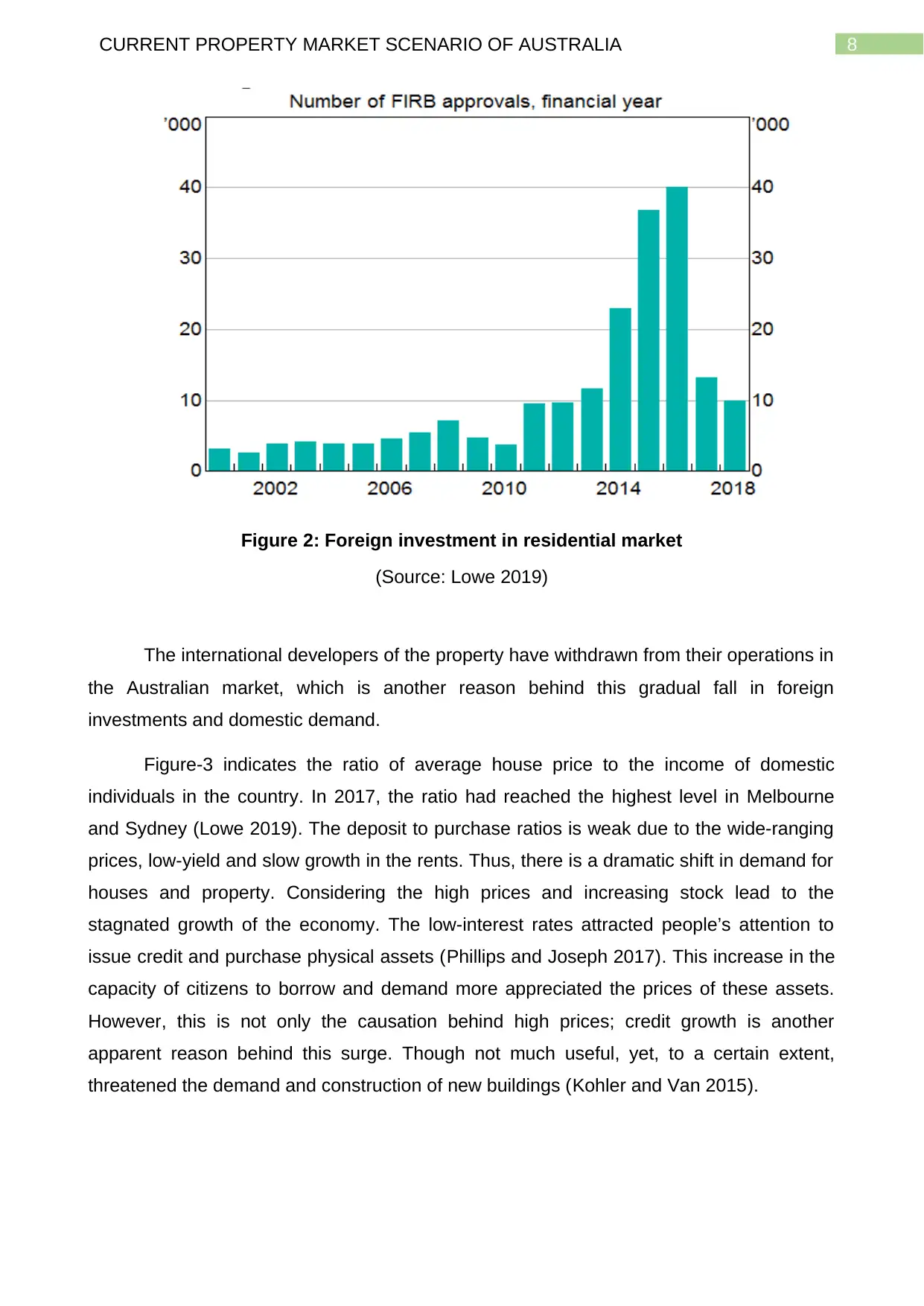
8CURRENT PROPERTY MARKET SCENARIO OF AUSTRALIA
Figure 2: Foreign investment in residential market
(Source: Lowe 2019)
The international developers of the property have withdrawn from their operations in
the Australian market, which is another reason behind this gradual fall in foreign
investments and domestic demand.
Figure-3 indicates the ratio of average house price to the income of domestic
individuals in the country. In 2017, the ratio had reached the highest level in Melbourne
and Sydney (Lowe 2019). The deposit to purchase ratios is weak due to the wide-ranging
prices, low-yield and slow growth in the rents. Thus, there is a dramatic shift in demand for
houses and property. Considering the high prices and increasing stock lead to the
stagnated growth of the economy. The low-interest rates attracted people’s attention to
issue credit and purchase physical assets (Phillips and Joseph 2017). This increase in the
capacity of citizens to borrow and demand more appreciated the prices of these assets.
However, this is not only the causation behind high prices; credit growth is another
apparent reason behind this surge. Though not much useful, yet, to a certain extent,
threatened the demand and construction of new buildings (Kohler and Van 2015).
Figure 2: Foreign investment in residential market
(Source: Lowe 2019)
The international developers of the property have withdrawn from their operations in
the Australian market, which is another reason behind this gradual fall in foreign
investments and domestic demand.
Figure-3 indicates the ratio of average house price to the income of domestic
individuals in the country. In 2017, the ratio had reached the highest level in Melbourne
and Sydney (Lowe 2019). The deposit to purchase ratios is weak due to the wide-ranging
prices, low-yield and slow growth in the rents. Thus, there is a dramatic shift in demand for
houses and property. Considering the high prices and increasing stock lead to the
stagnated growth of the economy. The low-interest rates attracted people’s attention to
issue credit and purchase physical assets (Phillips and Joseph 2017). This increase in the
capacity of citizens to borrow and demand more appreciated the prices of these assets.
However, this is not only the causation behind high prices; credit growth is another
apparent reason behind this surge. Though not much useful, yet, to a certain extent,
threatened the demand and construction of new buildings (Kohler and Van 2015).
⊘ This is a preview!⊘
Do you want full access?
Subscribe today to unlock all pages.

Trusted by 1+ million students worldwide
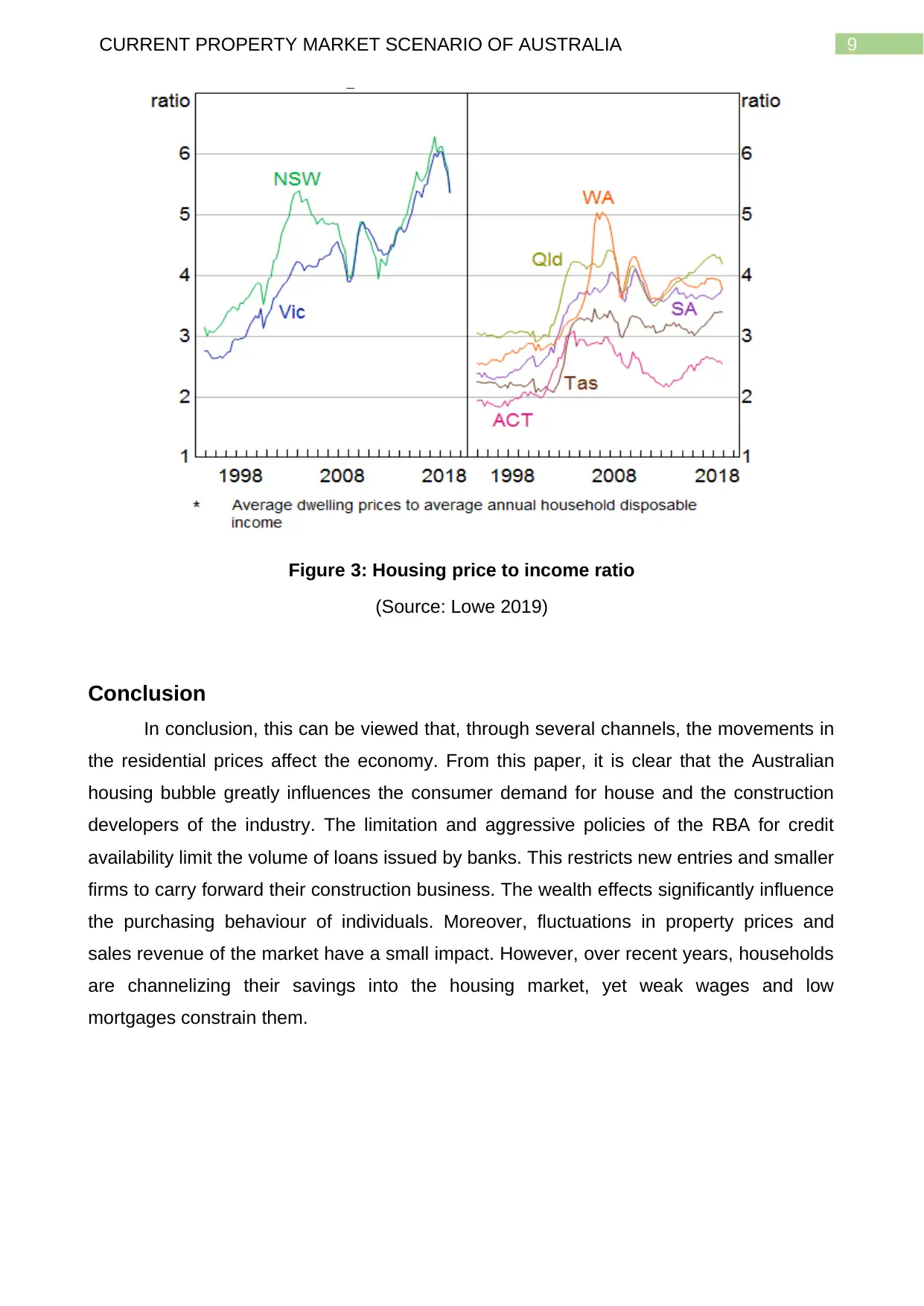
9CURRENT PROPERTY MARKET SCENARIO OF AUSTRALIA
Figure 3: Housing price to income ratio
(Source: Lowe 2019)
Conclusion
In conclusion, this can be viewed that, through several channels, the movements in
the residential prices affect the economy. From this paper, it is clear that the Australian
housing bubble greatly influences the consumer demand for house and the construction
developers of the industry. The limitation and aggressive policies of the RBA for credit
availability limit the volume of loans issued by banks. This restricts new entries and smaller
firms to carry forward their construction business. The wealth effects significantly influence
the purchasing behaviour of individuals. Moreover, fluctuations in property prices and
sales revenue of the market have a small impact. However, over recent years, households
are channelizing their savings into the housing market, yet weak wages and low
mortgages constrain them.
Figure 3: Housing price to income ratio
(Source: Lowe 2019)
Conclusion
In conclusion, this can be viewed that, through several channels, the movements in
the residential prices affect the economy. From this paper, it is clear that the Australian
housing bubble greatly influences the consumer demand for house and the construction
developers of the industry. The limitation and aggressive policies of the RBA for credit
availability limit the volume of loans issued by banks. This restricts new entries and smaller
firms to carry forward their construction business. The wealth effects significantly influence
the purchasing behaviour of individuals. Moreover, fluctuations in property prices and
sales revenue of the market have a small impact. However, over recent years, households
are channelizing their savings into the housing market, yet weak wages and low
mortgages constrain them.
Paraphrase This Document
Need a fresh take? Get an instant paraphrase of this document with our AI Paraphraser
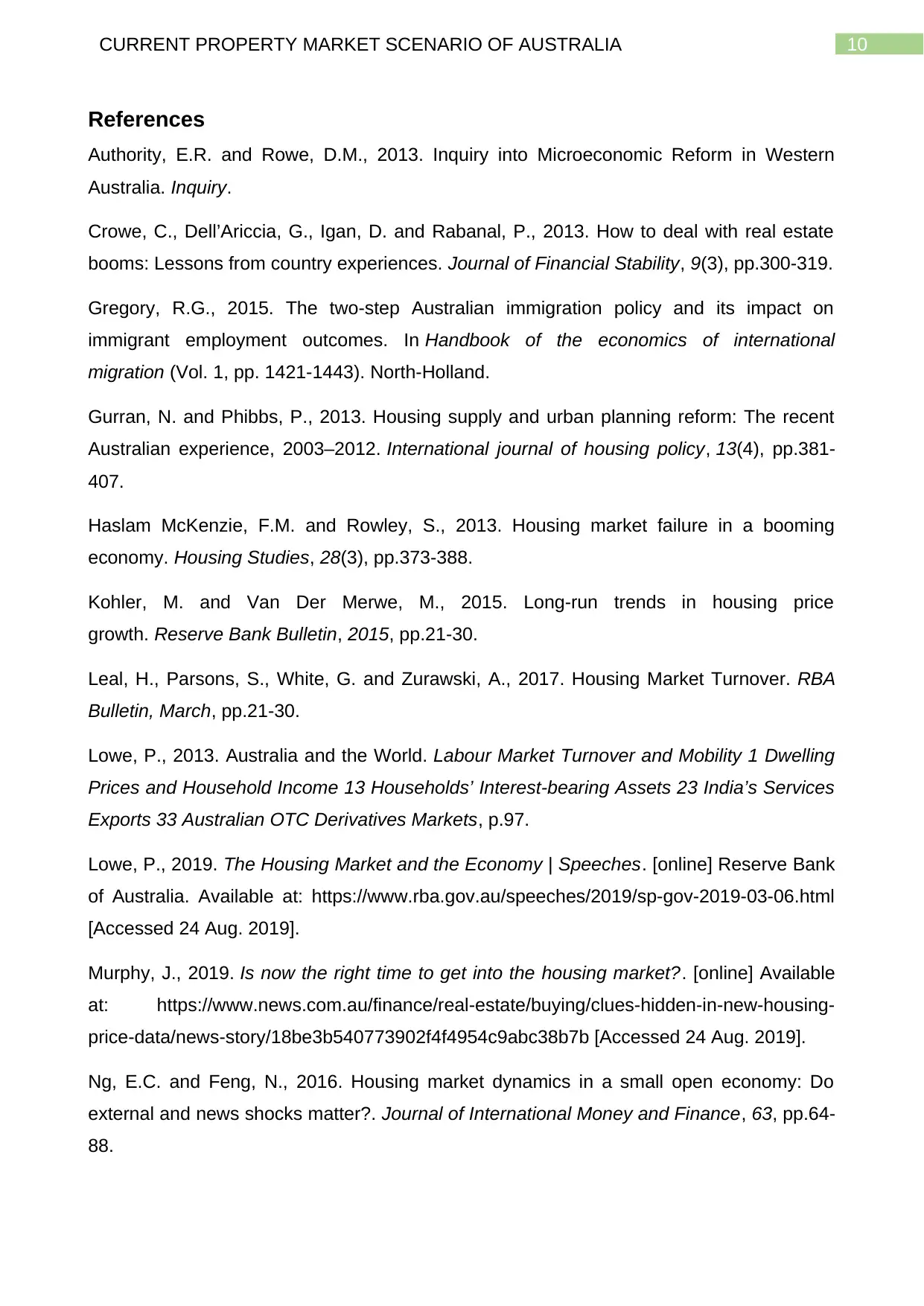
10CURRENT PROPERTY MARKET SCENARIO OF AUSTRALIA
References
Authority, E.R. and Rowe, D.M., 2013. Inquiry into Microeconomic Reform in Western
Australia. Inquiry.
Crowe, C., Dell’Ariccia, G., Igan, D. and Rabanal, P., 2013. How to deal with real estate
booms: Lessons from country experiences. Journal of Financial Stability, 9(3), pp.300-319.
Gregory, R.G., 2015. The two-step Australian immigration policy and its impact on
immigrant employment outcomes. In Handbook of the economics of international
migration (Vol. 1, pp. 1421-1443). North-Holland.
Gurran, N. and Phibbs, P., 2013. Housing supply and urban planning reform: The recent
Australian experience, 2003–2012. International journal of housing policy, 13(4), pp.381-
407.
Haslam McKenzie, F.M. and Rowley, S., 2013. Housing market failure in a booming
economy. Housing Studies, 28(3), pp.373-388.
Kohler, M. and Van Der Merwe, M., 2015. Long-run trends in housing price
growth. Reserve Bank Bulletin, 2015, pp.21-30.
Leal, H., Parsons, S., White, G. and Zurawski, A., 2017. Housing Market Turnover. RBA
Bulletin, March, pp.21-30.
Lowe, P., 2013. Australia and the World. Labour Market Turnover and Mobility 1 Dwelling
Prices and Household Income 13 Households’ Interest-bearing Assets 23 India’s Services
Exports 33 Australian OTC Derivatives Markets, p.97.
Lowe, P., 2019. The Housing Market and the Economy | Speeches. [online] Reserve Bank
of Australia. Available at: https://www.rba.gov.au/speeches/2019/sp-gov-2019-03-06.html
[Accessed 24 Aug. 2019].
Murphy, J., 2019. Is now the right time to get into the housing market?. [online] Available
at: https://www.news.com.au/finance/real-estate/buying/clues-hidden-in-new-housing-
price-data/news-story/18be3b540773902f4f4954c9abc38b7b [Accessed 24 Aug. 2019].
Ng, E.C. and Feng, N., 2016. Housing market dynamics in a small open economy: Do
external and news shocks matter?. Journal of International Money and Finance, 63, pp.64-
88.
References
Authority, E.R. and Rowe, D.M., 2013. Inquiry into Microeconomic Reform in Western
Australia. Inquiry.
Crowe, C., Dell’Ariccia, G., Igan, D. and Rabanal, P., 2013. How to deal with real estate
booms: Lessons from country experiences. Journal of Financial Stability, 9(3), pp.300-319.
Gregory, R.G., 2015. The two-step Australian immigration policy and its impact on
immigrant employment outcomes. In Handbook of the economics of international
migration (Vol. 1, pp. 1421-1443). North-Holland.
Gurran, N. and Phibbs, P., 2013. Housing supply and urban planning reform: The recent
Australian experience, 2003–2012. International journal of housing policy, 13(4), pp.381-
407.
Haslam McKenzie, F.M. and Rowley, S., 2013. Housing market failure in a booming
economy. Housing Studies, 28(3), pp.373-388.
Kohler, M. and Van Der Merwe, M., 2015. Long-run trends in housing price
growth. Reserve Bank Bulletin, 2015, pp.21-30.
Leal, H., Parsons, S., White, G. and Zurawski, A., 2017. Housing Market Turnover. RBA
Bulletin, March, pp.21-30.
Lowe, P., 2013. Australia and the World. Labour Market Turnover and Mobility 1 Dwelling
Prices and Household Income 13 Households’ Interest-bearing Assets 23 India’s Services
Exports 33 Australian OTC Derivatives Markets, p.97.
Lowe, P., 2019. The Housing Market and the Economy | Speeches. [online] Reserve Bank
of Australia. Available at: https://www.rba.gov.au/speeches/2019/sp-gov-2019-03-06.html
[Accessed 24 Aug. 2019].
Murphy, J., 2019. Is now the right time to get into the housing market?. [online] Available
at: https://www.news.com.au/finance/real-estate/buying/clues-hidden-in-new-housing-
price-data/news-story/18be3b540773902f4f4954c9abc38b7b [Accessed 24 Aug. 2019].
Ng, E.C. and Feng, N., 2016. Housing market dynamics in a small open economy: Do
external and news shocks matter?. Journal of International Money and Finance, 63, pp.64-
88.
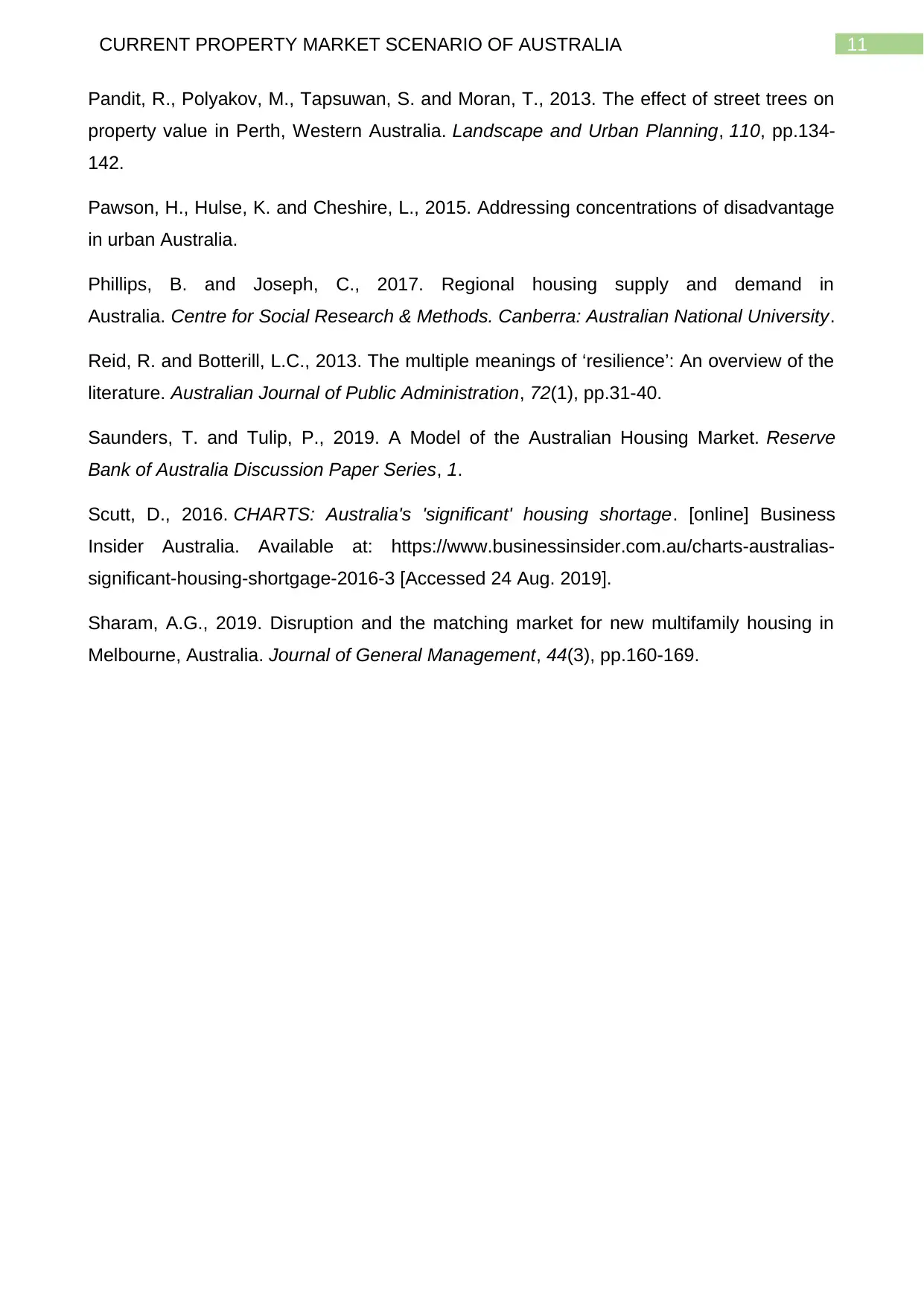
11CURRENT PROPERTY MARKET SCENARIO OF AUSTRALIA
Pandit, R., Polyakov, M., Tapsuwan, S. and Moran, T., 2013. The effect of street trees on
property value in Perth, Western Australia. Landscape and Urban Planning, 110, pp.134-
142.
Pawson, H., Hulse, K. and Cheshire, L., 2015. Addressing concentrations of disadvantage
in urban Australia.
Phillips, B. and Joseph, C., 2017. Regional housing supply and demand in
Australia. Centre for Social Research & Methods. Canberra: Australian National University.
Reid, R. and Botterill, L.C., 2013. The multiple meanings of ‘resilience’: An overview of the
literature. Australian Journal of Public Administration, 72(1), pp.31-40.
Saunders, T. and Tulip, P., 2019. A Model of the Australian Housing Market. Reserve
Bank of Australia Discussion Paper Series, 1.
Scutt, D., 2016. CHARTS: Australia's 'significant' housing shortage. [online] Business
Insider Australia. Available at: https://www.businessinsider.com.au/charts-australias-
significant-housing-shortgage-2016-3 [Accessed 24 Aug. 2019].
Sharam, A.G., 2019. Disruption and the matching market for new multifamily housing in
Melbourne, Australia. Journal of General Management, 44(3), pp.160-169.
Pandit, R., Polyakov, M., Tapsuwan, S. and Moran, T., 2013. The effect of street trees on
property value in Perth, Western Australia. Landscape and Urban Planning, 110, pp.134-
142.
Pawson, H., Hulse, K. and Cheshire, L., 2015. Addressing concentrations of disadvantage
in urban Australia.
Phillips, B. and Joseph, C., 2017. Regional housing supply and demand in
Australia. Centre for Social Research & Methods. Canberra: Australian National University.
Reid, R. and Botterill, L.C., 2013. The multiple meanings of ‘resilience’: An overview of the
literature. Australian Journal of Public Administration, 72(1), pp.31-40.
Saunders, T. and Tulip, P., 2019. A Model of the Australian Housing Market. Reserve
Bank of Australia Discussion Paper Series, 1.
Scutt, D., 2016. CHARTS: Australia's 'significant' housing shortage. [online] Business
Insider Australia. Available at: https://www.businessinsider.com.au/charts-australias-
significant-housing-shortgage-2016-3 [Accessed 24 Aug. 2019].
Sharam, A.G., 2019. Disruption and the matching market for new multifamily housing in
Melbourne, Australia. Journal of General Management, 44(3), pp.160-169.
⊘ This is a preview!⊘
Do you want full access?
Subscribe today to unlock all pages.

Trusted by 1+ million students worldwide
1 out of 12
Related Documents
Your All-in-One AI-Powered Toolkit for Academic Success.
+13062052269
info@desklib.com
Available 24*7 on WhatsApp / Email
![[object Object]](/_next/static/media/star-bottom.7253800d.svg)
Unlock your academic potential
Copyright © 2020–2025 A2Z Services. All Rights Reserved. Developed and managed by ZUCOL.





